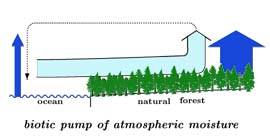New Russian theory relates rainfall decline, fires and climate change to forest removal
 In the light of the upcoming "Pause and Review" conference (November 9, 2014) on how Victoria's 5% per annum burning off will destroy most wildlife, along with forests and climate, I am revisiting the biotic pump theory on these pages. Whilst many people have been aware (but have mostly been ignored) that vegetation, especially forests, creates rain, and whilst desertification has been linked to deforestation historically many times, there is a new and robust theory to explain how this may happen. There is a short and a long version at Prof. Victor G. Gorshkov and Anastassia Makarieva's theoretical physics site here: "Biotic regulation pump." The authors also have pages at academia.edu. A journalist overview, "'Biotic Pump' Theory Suggests Forests Drive Wind and Rain" is available on the Environmental News Network.
In the light of the upcoming "Pause and Review" conference (November 9, 2014) on how Victoria's 5% per annum burning off will destroy most wildlife, along with forests and climate, I am revisiting the biotic pump theory on these pages. Whilst many people have been aware (but have mostly been ignored) that vegetation, especially forests, creates rain, and whilst desertification has been linked to deforestation historically many times, there is a new and robust theory to explain how this may happen. There is a short and a long version at Prof. Victor G. Gorshkov and Anastassia Makarieva's theoretical physics site here: "Biotic regulation pump." The authors also have pages at academia.edu. A journalist overview, "'Biotic Pump' Theory Suggests Forests Drive Wind and Rain" is available on the Environmental News Network.
See also How logging causes forest firesOriginal source of article:Rainforests may pump winds worldwide by Fred Pierce, New Scientist, 1st April 2009, issue no.2702.
Introduction
If you cut your forest, the winds will not blow from the ocean and will not bring you rain. Natural forests draw atmospheric moisture inland from the ocean in a positive feedback loop. This builds up precipitation inland, compensating for water lost through river flow and ultimately increasing river runoff due to the sustained low pressure area inland. Forests make rivers.

Due to their high leaf area index, natural forests maintain high transpiration fluxes (thick dark blue arrow), which exceed the evaporation fluxes over the ocean (thin dark blue arrow). The evaporated moisture undergoes condensation and disappears from the gas phase. Air in the atmospheric column above the forest rarifies. As a result, ascending air motion develops over the forest canopy, which, in turn, "sucks in" moist air from the ocean (light blue arrow). It then returns to the ocean in the upper atmosphere (dotted arrow) after precipitation of moisture over the continent.
Main findings
The-chicken-or-the-egg problem of whether forests grow where it is wet, or it is wet where the forests grow, solves unambiguously in favor of the forests' priority. Physical foundations for this conclusion (the non-equilibrium vertical distribution of atmospheric water vapor and the associated upward-directed force of osmotic nature, termed the evaporative force), as well as the empirical evidence (precipitation dependence on distance from the ocean in forested versus non-forested areas) illustrating the action of forest moisture pump and its decisive role in the maintenance of water cycle on land, are described.
Publications
Links to all our publications relevant to biotic pump.
Biotic Pump Overview 2012
Interview to Mongabay.com.
Biotic Pump Overview 2009
15 responses to the Spanish Meteorological Magazine.
Discussion
The biotic pump idea was first put forward in the end of 2005. Since that time many interesting comments and questions became available. Comprehensive discussion was hosted on the pages of the Hydrology and Earth System Sciences Discussions journal of the European Geosciences Union, where the biotic pump was first published and where it became one of the most commented papers. Some comments were made informally to the authors and some are anonymous. Here we give an overview of all the reactions, with our comments and responses to criticisms. Note that the Russian version of this section is not a translation of the English version. Instead, it publicizes our correspondence (in Russian) with the Editorial Boards of the Russian journals "Water Resources" and "Physics of Atmosphere and Ocean", including anonymous reviews and the authors' responses to them.
Miscellaneous
This section includes presentations of biotic pump at conferences; mass-media articles on biotic pump; and all other relevant issues not covered in the above sections. For example, in October 2007 an interesting prediction of the biotic pump theory was confirmed, namely that natural forests should increase transpiration during droughts (Saleska et al. 2007 Science 318: 612). Increased evaporation leads to intensification of the upwelling fluxes of moist air and of horizontal influx of moist air from the ocean, to offset the adverse effects of the drought. Forests that do regulate the water cycle are expected to behave like this. This behaviour was confirmed with satellite data on leaf area index in Amazon forests during the 2005 drought.

Recent comments